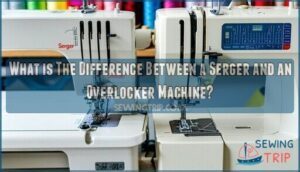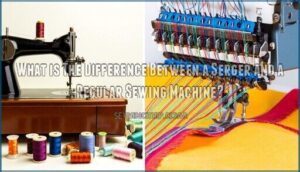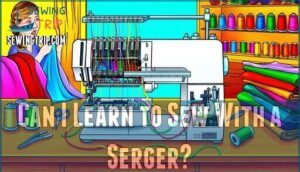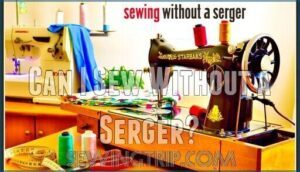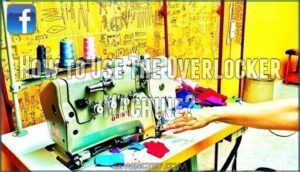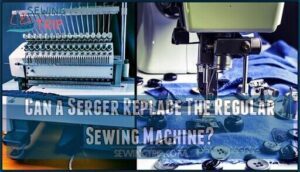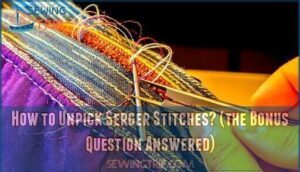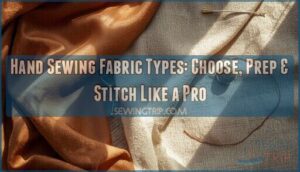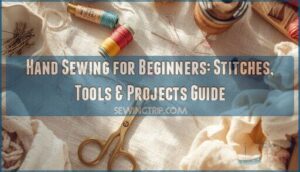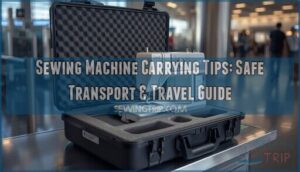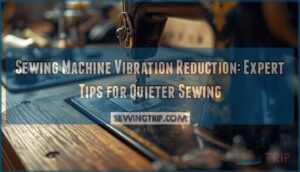This site is supported by our readers. We may earn a commission, at no cost to you, if you purchase through links.
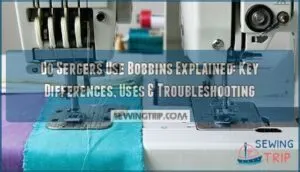
Instead of bobbins, sergers rely on loopers—mechanical arms that weave threads together to create that distinctive overlock stitch you see on store-bought clothing. Understanding this fundamental difference clarifies why sergers excel at finishing edges and working with knits, while your regular sewing machine tackles different tasks. Once you grasp how loopers work instead of bobbins, the rest of serger operation starts making sense.
Table Of Contents
- Key Takeaways
- Understanding Sergers
- What is The Difference Between a Serger and an Overlocker Machine?
- What is The Difference Between a Serger and a Regular Sewing Machine?
- What is a Serger/overlocker Used For?
- Can I Learn to Sew With a Serger?
- Can I Sew Without a Serger?
- How to Use The Overlocker Machine?
- Can a Serger Replace The Regular Sewing Machine?
- What Types of Overlockers/sergers Are There?
- Do I Need to Own a Serger?
- Which is The Best Serger Sewing Machine to Buy?
- How to Thread a Serger?
- How to Unpick Serger Stitches? (the Bonus Question Answered)
- Serger and Overlocker Troubleshooting
- Like What You Read Here? Support My Site
- Frequently Asked Questions (FAQs)
- Conclusion
Key Takeaways
- Sergers don’t use bobbins—they rely on loopers, mechanical arms that weave three to five threads together to create overlock stitches that trim, stitch, and finish edges in one pass.
- While sergers excel at finishing edges and working with stretchy fabrics quickly, they can’t replace regular sewing machines because they lack straight stitch capability, can’t handle buttonholes or zippers, and aren’t suited for topstitching or detailed work.
- Threading a serger correctly (following upper looper first, then lower looper) prevents most malfunctions, with incorrect threading causing over 60% of troubleshooting issues and requiring careful attention to tension settings and thread paths.
- Regular maintenance like replacing needles every 8-16 hours, cleaning lint from feed dogs and knife blades, and proper tension adjustment keeps sergers running smoothly and prevents common problems like thread breaks and skipped stitches.
Understanding Sergers
If you’re new to sergers, it’s easy to feel a bit overwhelmed by all the moving parts. Let’s break down what makes these machines unique and how they fit alongside your regular sewing setup.
Here’s what you need to know before you get started.
What is a Serger?
Think of a serger as your sewing sidekick—it’s the machine that stitches, trims, and tidies up fabric edges all at once. Using a looper system instead of a bobbin, sergers create strong overlock stitches. The serger anatomy includes loopers and needles working together for clean, professional seams.
- Overlock stitch for durability
- Loopers replace bobbins
- Trims and finishes edges
Why Do I Need a Serger? Can’t I Just Use My Sewing Machine?
Once you see how a serger tidies up raw edges in one swift move, you’ll start wondering if your regular sewing machine can keep up. Sergers excel at Speed Comparison and Seam Durability, especially on tricky Fabric Types. If Professional Finishes matter to you, consider these advantages:
- Overlock stitch for strong seams
- Quick, clean edge trimming
- Ideal for stretchy projects
Why Are There So Many Threads?
If you’ve ever wondered why a serger looks like it’s hosting a tangle of threads, it’s because all those lines work together to give your seams that sturdy, polished finish your regular sewing machine just can’t match. Each looper thread follows a specific order, affecting tension and stitch formation.
Here’s a quick comparison:
| Thread Type | Impact on Stitch |
|---|---|
| Looper thread | Forms loops, adds stretch |
| Needle thread | Anchors seams |
| Decorative thread | Boosts color combos |
| Serger thread | Runs smoothly, reduces lint |
I’m a Little Nervous About The Knives. Are They Safe and Easy to Use?
After seeing all those threads in action, it’s normal to pause and wonder if the serger’s built-in knives are really as safe and easy to use as they claim. Knife safety starts with keeping fingers clear and knowing your serger machine parts.
Blade adjustments and cutting widths are straightforward, but routine maintenance is key to accident prevention. Treat the cutting blade with respect—never rush.
Will a Serger Replace My Sewing Machine?
While a serger brings speed and a polished look to your seams, your sewing machine still holds its own for everyday stitching tasks. For Project Suitability, basic repairs, and buttonholes, you’ll need your sewing machine.
Sergers excel at overlock stitches but lack the adaptability of bobbins and straight stitching, making both machines essential depending on Skill Level, Space Constraints, and Budget Considerations.
What is The Difference Between a Serger and an Overlocker Machine?
Though the terms “serger” and “overlocker” often pop up together, they’re basically the same type of machine—just called different names depending on where you live. In North America, you’ll hear “serger”; in Europe and Australia, “overlocker” is the go-to. Both machines perform the same job: trimming, stitching, and overcasting fabric edges in one pass. There’s no technical difference in how they operate, the terminology differences are purely regional. Some brands might tweak features or offer extra stitch options, but the core function stays the same. If you’re comparing a serger vs overlocker, think of it like comparing “soda” and “pop”—different words, same thing.
Understanding these naming quirks helps you shop and troubleshoot with confidence. Sergers are great for creating flexible and stretchy seams, making them ideal for knits.
What is The Difference Between a Serger and a Regular Sewing Machine?
A key difference between a serger and a regular sewing machine lies in how each forms stitches and finishes seams. Your sewing machine uses bobbins and a needle thread to create lockstitches, managing everything from buttonholes to topstitching.
Sergers, on the other hand, rely on loopers—mechanical arms that weave three to five threads for overlock stitches. This means sergers can trim, stitch, and overcast edges in one pass, producing a flatter, more durable seam. If you’re after a professional finish, sergers excel at encasing raw edges and preventing fraying.
But don’t toss your sewing machine—its adaptability covers tasks sergers can’t do, like straight stitching or zippers. Think of them as complementary tools, each with its own strengths. Sergers are also ideal for creating finished seams with no raw edges.
What is a Serger/overlocker Used For?
Ever wondered how clothing gets those perfectly finished edges that never seem to fray, no matter how often you wear them? That’s the work of a serger, or overlocker. You’ll find it indispensable for Edge Finishing and Seam Construction, especially on knit fabrics. Sergers use an overlock stitch, trimming and enclosing raw edges in one quick pass. For instance, when working with stretchy materials, overlocking keeps seams strong and flexible. If you’re aiming for professional results, a serger tackles these tasks with speed and precision.
Here’s what you can do with a serger:
- Finish edges to prevent fraying
- Join seams on knits and wovens
- Create rolled hems
- Add decorative stitches for unique project applications
Can I Learn to Sew With a Serger?
If you’ve ever looked at a perfectly finished seam and wondered how it’s done, you’ll be glad to know that mastering a serger is well within your reach. The serger learning curve is real, but with beginner serger projects and a focus on serger first steps, you’ll progress quickly.
Unlike a sewing machine, sergers don’t use bobbins, so threading and tension take some practice. As a beginner sewer, you’ll notice your serger skill progression with each project—precision and speed come naturally.
Can I Sew Without a Serger?
You don’t need fancy equipment to sew well—your regular sewing machine can manage almost anything with a bit of know-how and the right tools. Serger vs sewing machine debates aside, you’re not limited by equipment—just adapt your methods to suit your project.
For seam finishing, try using a zig zag or overlock stitch; these alternative stitches help prevent fabric fraying, especially on woven materials. Pinking shears are another practical option, especially if you’re working with project limitations or don’t have a dedicated overlocker. While a serger excels at knit fabrics and rapid seam construction, a sewing machine gives you adaptability and control.
Pressing seams carefully adds polish and durability, making your work crisp and professional. With thoughtful technique, quality supplies, and a creative mindset, you’ll achieve strong, neat seams every time.
How to Use The Overlocker Machine?
Once you’re comfortable sewing with your regular machine, stepping up to an overlocker can feel like unlocking a new set of tools for speed and precision. Overlocker machine usage starts with careful threading—each looper and needle needs its own thread. Take your time; use tweezers if needed.
Adjusting Fabric Tension and Differential Feed lets you work with everything from lightweight knits to thick wovens without puckering. Want a professional finish? Try Rolled Hemming for napkins or scarves. Decorative Threads can turn plain seams into standout details. For construction, experiment with the Chain Stitch for strong, stretchable seams.
Don’t forget these essentials:
- Check thread paths regularly
- Clean lint after each project
- Oil moving parts as needed
- Practice serger threading techniques
- Consult a serger troubleshooting guide
Can a Serger Replace The Regular Sewing Machine?
After exploring what an overlocker can do, it’s natural to wonder if your serger could take over every job your regular sewing machine performs. Here’s the thing—sergers excel at finishing edges with an overlock stitch and trimming fabric in one pass, but they’ve limitations. You won’t find a bobbin or straight stitch option, so tasks like buttonholes, topstitching, or basic repairs are better suited to a sewing machine.
For most projects, hybrid sewing is the answer. Use your serger for clean, durable seams, then switch to your sewing machine for details and creative applications.
Take a look at this quick comparison:
| Serger Limitations | Sewing Machine Adaptability |
|---|---|
| No bobbin | Uses bobbin |
| Overlock stitch only | Multiple stitch types |
| Trims seam allowance | No built-in cutter |
| Fast, professional seams | Precision for details |
| Limited for repairs | Great for repairs |
What Types of Overlockers/sergers Are There?
When comparing serger machine types, you’ll find options for every workspace and skill level. Industrial Overlockers crank out stitches fast for factories, while Heavy-Duty Models tackle thick fabrics without flinching. Portable Sergers suit home use—compact and easy to store. Combination Machines blend overlocking with coverstitch functions for added adaptability. Automated Features, like self-threading and tension control, make setup a breeze. Each type addresses different tasks, so choosing the right one depends on your sewing goals and the fabrics you work with.
- Combination Machines offer overlock and coverstitch in one unit.
Do I Need to Own a Serger?
Choosing the right type of serger is only half the story—the real question is whether adding one to your sewing setup is worth it for what you want to achieve. Think about your project suitability, cost justification, and available space.
If you work often with knits or fabrics that fray, a serger makes sense. Professional sewing benefits from overlock stitch adaptability and speed.
But if your skill level or fabric preferences lean toward basic seams, a sewing machine alone may be enough.
Which is The Best Serger Sewing Machine to Buy?
Choosing the right serger can make your sewing projects easier and more professional. There are a few standout machines worth considering, each with its own strengths.
Here’s a look at some top options to help you find the best fit for your needs.
Brother Serger DZ1234 Metal Frame Overlock Machine
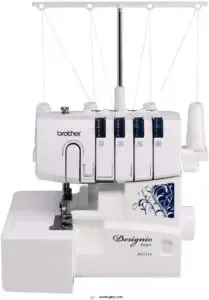
Looking for a serger that feels sturdy, runs fast, and makes threading less of a headache? The Brother DZ1234 Metal Frame Overlock Machine stands out for those reasons and more. You’ll notice its DZ1234 Features make a difference, especially with:
- Durable Metal Frame for stability
- Adjustable stitch width for better Stitch Quality
- Color-coded guides for Threading Ease
- Accessory feet for varied Project Ideas
- Numbered loopers—no Bobbins, just classic Sergers engineering
If you’re curious about the differences between bobbins and loopers, this serger’s components show you how a modern machine streamlines your workflow.
Yamata High Speed Industrial Serger Overlock
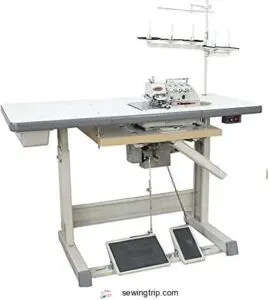
If fast, reliable stitching is what you’re after, the Yamata High Speed Industrial Serger Overlock steps up with impressive speed and steady results. With Yamata Speed reaching up to 7500 stitches per minute, it’s built for industrial applications where time and stitch quality matter.
You’ll appreciate its auto lubrication and low tension setup, plus threading specifics are straightforward—just loopers, no bobbin. Regular maintenance keeps it running smooth, making this serger a workhorse.
JUKI MO654DE Portable Thread Serger Sewing Machine
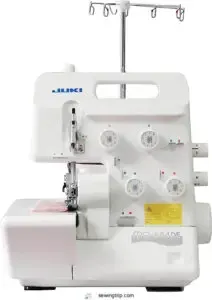
Adaptability is the standout feature of the JUKI MO654DE Portable Thread Serger, making it a trusted choice for taking on everything from delicate silks to sturdy denim. You’ll find its JUKI Features practical: color-coded Threading Guide, adjustable Stitch Settings, and a differential feed that manages tricky fabrics. No bobbins here—just loopers, which means fewer jams and smoother seams. Beginners might need patience with threading, but the payoff is worth it.
For best results, remember these:
- Clean and oil regularly (Maintenance Tips)
- Use quality serger thread
- Explore creative Project Ideas
- Understand differences between bobbins and loopers
How to Thread a Serger?
Threading a serger can feel like solving a puzzle, but once you know where each thread goes, the process gets much smoother. Always follow the looper threading order—upper first, then lower. Use threading tools like tweezers for tricky spots. If your serger offers jet-air threading or self-threading, take advantage of it.
Keep these tips in mind:
- Follow threading guides and diagrams closely
- Adjust tension after threading
- Clean and oil before starting
- Troubleshoot breaks by rethreading carefully
Patience pays off with every stitch.
How to Unpick Serger Stitches? (the Bonus Question Answered)
Mistakes happen, and removing serger stitches without damaging your fabric requires a careful approach and the right technique. Here’s how to tackle serger seam ripping effectively:
- Use sharp, fine-tipped scissors or tweezers. These are the best unpicking tools for gripping and snipping individual needle threads without snagging delicate fabrics.
- Locate and cut the needle threads first. Once severed, the looper threads unravel more easily, preventing fabric damage.
- Pull gently from the fabric’s right side. This prevents weaving them into the fabric fibers and makes re-sewing after unpicking cleaner.
Work slowly through each section of your serger stitches. Unpicking serger stitches takes patience, but proper technique protects your seam integrity for a fresh start.
Serger and Overlocker Troubleshooting
Incorrect threading is the leading cause of serger malfunction, accounting for more than 60% of troubleshooting cases. When your machine acts up, start by checking the threading path—missed guides or wrong threading order often trigger tension problems and thread breakages.
Replace needles every 8-16 hours of use, since dull or bent needles cause 30% of skipped stitches. Clean lint from feed dogs and around knife blades regularly to prevent fabric feeding issues. Adjust presser foot pressure if your fabric puckers or bunches, and verify tension settings match your thread type and fabric weight.
| Problem | Fix |
|---|---|
| Thread breaks constantly | Rethread entire machine; check for old or weak thread |
| Uneven or skipped stitches | Replace needle; verify correct insertion with flat side back |
| Fabric won’t feed smoothly | Clear lint from feed dogs; adjust presser foot pressure |
| Jagged cuts along edge | Replace dull knife blades; remove fabric dust buildup |
Like What You Read Here? Support My Site
Now that you’ve learned how to troubleshoot your serger, you might find this article helpful enough to support the work that went into creating it. As a sewing machine technician and instructor, I create detailed guides explaining how sergers work without bobbins, why they use loopers instead, and how to maintain your equipment. Your support helps me continue producing practical content on topics like threading, tension adjustments, and the differences between sergers and regular sewing machines.
Here’s how you can help:
- Share Your Experience – Leave comments about your serger projects or join our community discussions where sewists exchange tips on everything from fabric manipulation to knife blade maintenance.
Supporting this site means more troubleshooting guides, maintenance tutorials, and answers to your questions about overlockers and conventional machines alike.
Frequently Asked Questions (FAQs)
Does a serger use a bobbin?
No, sergers don’t use bobbins at all—they rely on loopers instead. Think of loopers as specialized mechanical arms that work with needles to create those signature overlock stitches, eliminating the need for bobbin thread entirely.
Does a home sewing machine have a bobbin?
Yes, home sewing machines use bobbins. The bobbin holds the bottom thread that interlocks with the top needle thread to create each stitch.
Bobbin types include vertical bobbin and horizontal bobbin configurations, with specific bobbin materials and installation methods.
How is a serger different from a sewing machine?
The main distinction lies in stitch formation and cutting capability. Sergers use loopers instead of bobbins, trim fabric edges while stitching, and manage knit fabrics with remarkable speed compared to traditional sewing machines.
How many threads does a serger machine have?
Most sergers use between two and five threads simultaneously. A basic two-thread machine performs simple edge finishing, while three-thread and four-thread models balance upper looper, lower looper, and needle threads for stronger seams with proper thread tension balance.
Can a serger be used for sewing?
Picture thread flowing like a choreographed dance—that’s what a serger does best. A serger can sew seams, but it’s designed for encasing edges, not topstitching or zippers.
Creative sewing options expand when you pair your serger with a traditional sewing machine for complete project adaptability.
How does a serger work?
A serger machine uses needles and loopers—an upper looper and lower looper—that weave threads together at high speed. The needle penetrates fabric while loopers catch and interlock threads around the edge.
Differential feed controls fabric movement, tension control balances threads, and the cutting system trims excess seam allowance simultaneously during stitch formation.
What types of fabrics work best with a serger?
Which fabrics truly shine on a serger? Knit fabrics, stretch fabrics, and lightweight woven fabrics work best. Your serger creates flexible, durable seams that withstand stretching without breaking.
Perfect for athletic wear, lingerie, children’s clothing, and soft furnishings where durability matters.
How do I clean lint and threads out of my serger?
Start by unplugging your serger for safety. Use a small brush to remove lint from the throat plate, feed dogs, tension discs, and loopers. Tweezers help extract threads wound around moving parts. Regular cleaning prevents lint buildup, which causes issues like skipped stitches.
What accessories are useful to have for a serger?
Like a well-stocked toolbox makes repairs easier, having the right serger accessories transforms your sewing experience. Extra needles, thread cones in various colors, tweezers and awls for threading loopers, thread nets to prevent tangling, cone stands for stability, a lint brush for maintenance, and specialty feet for different techniques.
How do I adjust the tension on a serger?
Locate your tension dials, usually numbered for each thread. Turn clockwise to tighten, counterclockwise to loosen. Start with the needle threads, then adjust looper tension.
Test on scrap fabric, checking for balanced stitches where threads interlock evenly at the fabric edge.
Conclusion
Sergers have revolutionized home sewing forever—once you understand they skip bobbins entirely, everything clicks. Now you know do sergers use bobbins explained: they don’t. Loopers manage thread circulation, knives trim fabric edges, and multiple threads create professional finishes your regular machine can’t match.
You’ve learned threading techniques, troubleshooting methods, and when each machine benefits you best. Thread your serger with confidence, test on scrap fabric first, and watch those raw edges transform into clean, stretchy seams that hold through countless washes.
- https://www.sewingmachinesplus.com/understanding-sergers.php
- https://mermaidsden.com/blog/2016/07/14/sewing-hacks-tested-can-you-really-use-serger-thread-instead-of-regular-thread-with-your-sewing-machine
- https://sewmadeira.com/blog/using-decorative-thread-with-a-serger
- https://edisonvacuums.com/serger-vs-sewing-machine-whats-the-difference/
- https://nanasewing.com/serger-vs-sewing-machine/

